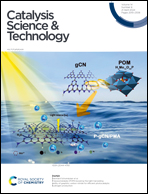Indirect use of CO2: synthesis of N-substituted dicarbamates via polyurea intermediates over a Zn-based metal azolate framework†
Abstract
N-substituted carbamates have become a potential raw material for the non-phosgene synthesis of isocyanates through thermal cracking. The direct synthesis of carbamates from CO2, diamines, and alcohols without a dehydration reagent should be an ideal choice; however, the yield is very low. Herein, we report an effective route for the synthesis of N-substituted dicarbamates via the catalytic alcoholysis of polyurea intermediates, whereby polyurea could be facilely synthesized from CO2 and diamines. A metal azolate framework composed of zinc coordinated with 5-amino-1H-tetrazole denoted as Zn(ATZ)2 was prepared and characterized using various physicochemical techniques (ICP, BET, FTIR, XRD, TGA, XPS, SEM). The developed Zn(ATZ)2 exhibited excellent catalytic activity for the synthesis of N-substituted dicarbamates via the alcoholysis of polyureas, and a 98% polyurea conversion with 96% diethyl hexamethylenedicarbamate (EHDC) yield could be achieved, which accomplished the indirect use of CO2. The brilliant catalytic performance of Zn(ATZ)2 could be attributed to the new active center after Zn species coordinated with ATZ. Moreover, the catalyst was reusable without any significant decrease in activity.



 Please wait while we load your content...
Please wait while we load your content...